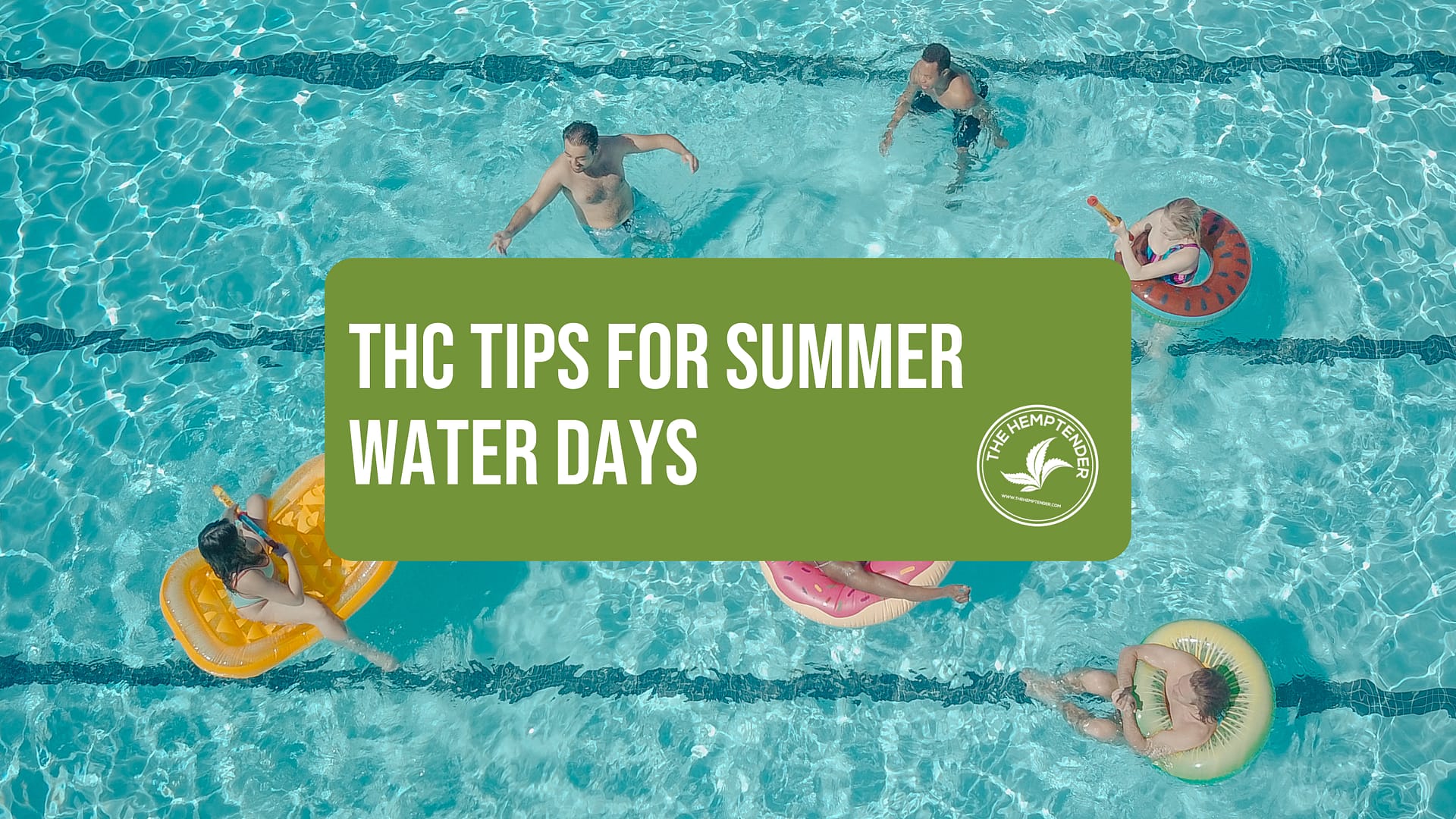Stay Cool and Collected: THC Tips for Water Days

There’s something about summer that makes a good high hit even better. Whether you’re floating on the lake, dipping into a cold plunge, or just soaking up sun by the pool, a little THC can make the whole experience feel more relaxed, more vibrant, more… everything.
But water and weed don’t always mix the way people think they do.
Cannabis affects more than just your headspace. It shifts how your body responds to heat, cold, movement, and even thirst. That matters when you’re navigating slippery pool decks, fast-moving rivers, or hot tubs on a 90° day. If you’re planning to mix weed with water this summer, a little awareness goes a long way.
Let’s break it down.
How THC Affects Your Body in Motion
Cannabis subtly changes how your body moves, reacts, and responds to your surroundings. That’s not always a big deal, but if you’re spending time near water, it’s good to know what’s happening under the surface.
Balance and coordination might be a little off.
THC affects the cerebellum and basal ganglia, two brain regions that play a major role in motor control and coordination. The result? Slightly slower movements, wobbly footing, or a misstep here and there. Around water, where surfaces are slippery or uneven, that can catch you off guard if you’re not paying attention.
Your sense of space can shift.
Cannabis can temporarily disrupt proprioception, the body’s ability to sense where it is in space. That’s why even simple movements, like climbing into a kayak, floating in deeper water, or walking along a riverbank, might feel a little less intuitive than usual.
Reflexes slow down.
THC is known to delay reaction time, especially at higher doses. Whether it’s stumbling over a rock, slipping off a step, or getting caught in a surprise current, your body might take a second longer to respond. That’s why slower-paced, low-stakes settings are best if you’re high around water.
Your body’s internal thermostat gets a little fuzzy.
THC also influences the hypothalamus, the part of the brain responsible for regulating body temperature. That can make hot tubs feel hotter, cold plunges feel colder, and long sun exposure more draining than you expect. It’s not a major shift, but it’s something to stay mindful of, especially in extreme temps.
You don’t need to overthink any of this—just tune in. Know how your body’s feeling, move a little slower, and plan to stay somewhere safe and steady. Cannabis can absolutely enhance your time in and around water, as long as you give yourself space to enjoy it responsibly.
THC and Hydration—Is Dry Mouth Dehydration?
Dry mouth is one of the most common side effects of THC, and it’s especially noticeable in the summer when you’re already sweating, sunbathing, or swimming.
But here’s the thing: dry mouth doesn’t automatically mean you’re dehydrated.
THC affects the submandibular glands, which are responsible for producing saliva. It essentially tells them to slow down, which leads to that familiar cottonmouth sensation. This is a localized effect—not the same as dehydration, which involves fluid loss throughout your entire body.
That said, cannabis can still set you up for dehydration indirectly.
- It may dull your thirst cues, so you don’t feel thirsty even when your body needs water.
- Being high might make you forget to hydrate, or you might reach for another THC drink instead of actual water.
- You’re often more active during summer adventures, meaning your body is losing water through sweat, especially in humid conditions or at high altitudes.
Also worth noting: being in water can make you feel cooler than you actually are. So you might not realize how much sun or heat you’ve absorbed until you’re already drained.
The bottom line? Dry mouth isn’t dangerous, but it’s a signal—your body’s telling you it’s time for some actual hydration. If you’re out in the sun or on the water, aim to sip 8 to 10 ounces of water every hour, especially if you’ve got THC in your system. Pack more water than you think you’ll need—and no, your infused lemonade doesn’t count.
Water Activities, Weed, and Real Risk
Cannabis might feel low-stakes (especially compared to alcohol) but that doesn’t mean it’s risk-free. When you mix it with water activities, even a mild high can change how you respond to your environment.
Reaction time, judgment, and coordination all take a small hit.
That matters when you’re wading into deep water, getting in and out of a kayak, or swimming in open water with no lifeguard nearby. A little lag in reflexes or a moment of confusion isn’t a big deal on land. In water? It can get serious, fast.
Environment plays a huge role, too.
Fast-moving rivers, sharp rocks, hidden drop-offs, or slick surfaces don’t leave much room for error. Even mellow activities like tubing or floating can be unpredictable depending on current, wind, and who you’re with. And if you’re high, your ability to problem-solve or course-correct might not kick in until it’s too late.
It’s not about how “high” you are. It’s about whether you’re clear enough to react. You don’t need to be blazed out of your mind for things to go sideways. It only takes a second of hesitation or one slow reaction for a situation to shift from funny to dangerous. And once you’re in the water, things move quickly.
This isn’t a scare tactic—it’s just the reality of how THC interacts with movement, depth, and unpredictability. The key isn’t to avoid cannabis altogether. It’s to know when and where to enjoy it. Save the elevation for solid ground, still water, and chill energy. Keep the high-stakes stuff for when you’re fully alert.
Pro Tips for Safe, Chill Summer Highs Near Water
You don’t need to avoid cannabis just because you’re heading to the lake or lounging by the pool. But if you’re going to mix weed with water, set yourself up for a good time, not a recovery story. Here’s how to keep it light, safe, and actually fun:
- Start low and give it time to kick in. If you’re new to edibles or THC drinks, or you’re in a new environment, don’t assume you know how your body will react. Start small and wait before diving in—literally or otherwise.
- Hydrate like it’s part of the plan. Pack more water than you think you’ll need, and drink it regularly—especially if you’re in the sun or physically active. Aim for 8–10 ounces every 30 minutes when outdoors with THC in your system.
- Stick to chill environments. Backyard pools, shaded patios, and mellow float trips are ideal. Fast rivers, cliffs, boats with motors, and deep or unpredictable water? Not the place to experiment.
- Don’t get high alone in or near water. Even if you feel confident, always have someone else around who’s either sober or clear-headed enough to help if needed. Cannabis is safer (and more fun) with a buddy system.
- Check your setting, check yourself. Are you overheating? Feeling dizzy? Unsure about the terrain? It’s okay to bow out or take a break. Your body will tell you what it needs—just make sure you’re listening.
- Snacks, shade, and electrolytes are your friends. Heat, THC, and low blood sugar don’t mix well. Bring salty snacks, fruit, or a sports drink to keep your energy up and your vibe steady.
Stay Smart, Stay Cool, Stay Elevated
Cannabis can absolutely enhance your summer, but only if you understand how it affects your body. From delayed reflexes to dry mouth and everything in between, a little awareness goes a long way when you’re mixing weed with movement, heat, and water.
You don’t need to overthink it, and you definitely don’t need to miss out. Just slow down, check in with yourself, and plan your high for the kind of setting that keeps you grounded—literally and otherwise.
At The Hemptender, we’re all about helping you elevate safely, seasonally, and on your own terms. Whether you’re looking for mellow THC drinks, microdose edibles, or just a few tips for navigating summer highs with confidence, we’ve got the products (and the guidance) to support your vibe.
Stock up, stay hydrated, and keep it steady out there. Summer hits harder when you’re clear enough to enjoy it.




